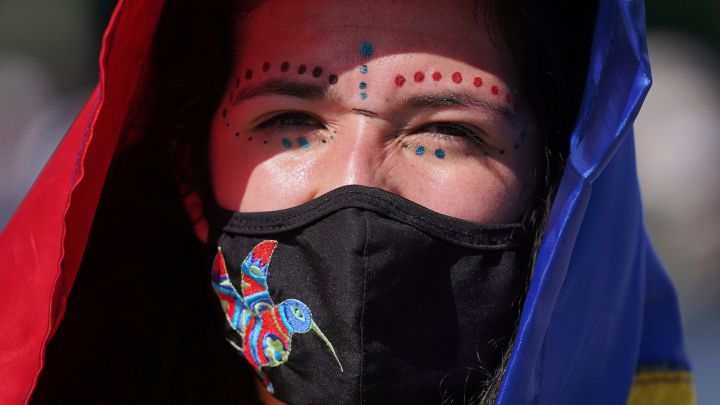RIO DE JANEIRO, BRAZIL – While Colombia is going through one of its worst social and political crises due to protests, deaths due to coronavirus are close to 80,000, and the country is unable to overcome the third wave of the pandemic that keeps the hospital system collapsed in several cities of the country.
Colombia added on Thursday 19,160 cases and 499 deaths, bringing the total number of infections to 3,067,879 and 79,760 deaths in one of the most critical moments of the health emergency due to the high occupation of intensive care units (ICU) to which more and more serious patients are arriving.

Experts warn that this wave could have no limit because it is impossible to lock people in strict quarantine after more than a year of a pandemic. The country should be applying an average of 300,000 doses of the vaccine per day, but it does not reach 200,000.
“This wave has no ceiling. We have no predictability, I really do not think that new cases will go down while people are in the streets, especially with the protests,” warns infectious disease specialist Carlos Torres Martinez.
In his opinion, the National Vaccination Plan, with which 7,044,644 doses of the vaccine have been administered, is advancing very slowly “to an extreme degree”, so that “as long as we do not have protection, we are going to have an extended peak that can last for months”.
“In this (peak) we have been since April with 500 deaths a day, and we will continue like this, or it will increase even more as long as there is no proper care for each person, not depending on being locked up, and if there is no vaccination it is the perfect storm for the wave to continue,” he added.
SEVERITY IN YOUNG PATIENTS
The most critical situation is faced by Bogotá, which remains in hospital red alert and yesterday added 7,742 infections and 131 deaths, the second-highest daily report of cases and fatalities since the pandemic began. At the same time, the occupation of intensive care units (ICU) passed 94%.
Hundreds of patients in the Colombian capital, the region most affected by the pandemic with 852,988 infections, are waiting for the assignment of an ICU bed, which is increasingly difficult because young patients remain hospitalized longer.
“We are in a situation in which the growth of contagion has been significant. We have a particularity, and that is that it is affecting a younger population, which tends to last more days in the ICU and that makes the difference with the past peaks”, warned the Minister of Health, Fernando Ruiz.
This condition is due, according to Torres, to the normal migration of the virus, given that there is a certain level of vaccination in older people who, being protected, are less infected or get sick less severely, and because a large part of the older population has already been infected and has immunity, even if only partial.
“That’s why you see younger people increasingly infected and in intensive care and more serious because of that. In addition, young people often tend to feel immune to the coronavirus and are quite irresponsible in their day-to-day activities,” the infectious disease specialist said.
CONTAGION OF THE MAYOR OF BOGOTÁ
A day after desperately stating that she no longer knows what to “say, warn, beg, plead” about the serious health situation in the city, the mayor of Bogotá, Claudia Lopez, reported this Friday that she tested positive in a PCR test for coronavirus. However, she has mild symptoms and will remain at rest on medical advice.
The local mayor made an urgent request “to the national government and the Strike Committee to establish without further delay a national negotiation table”, necessary to “move on to the building of trust, to clear rules, to a clear method of social and economic agreement”.
Two weeks ago, when the labor centers and unions called for the demonstrations, health experts warned that the crowds in the streets, which hundreds of thousands of people have attended, would coincide with the most critical moment of the third wave of the pandemic, which in April alone left more than 10,000 deaths in the country.
However, and despite the high numbers reported in other regions such as Antioquia, Atlántico, and Valle del Cauca (the epicenter of the mobilizations), the protests continue to gather thousands of people daily, many of whom do not comply with biosecurity measures such as the use of masks and physical distancing.
RISK DUE TO CROWDS
The health minister warned that the effects of the massive demonstrations against the policies of the government of President Iván Duque’s administration are already being reflected in the daily figures.
“What remains to be seen is the effect that may occur when young people in the streets return to their homes and contagions are generated,” he said about the crisis.
However, the infectologist Torres clarifies that the increase of contagions and deaths should not be explained only from the concentrations in the streets since the country entered the third wave of the pandemic in April. There are variants of greater transmissibility of the virus circulating in the country.
“The usefulness of restrictions (such as curfews and dry law) is much less when people are in the streets and crowds, but we should not blame only the people who are protesting. Since before, the numbers were going up and are going up because the restrictions are impossible to comply with socially because there is fatigue of society to stay locked up,” he said.

